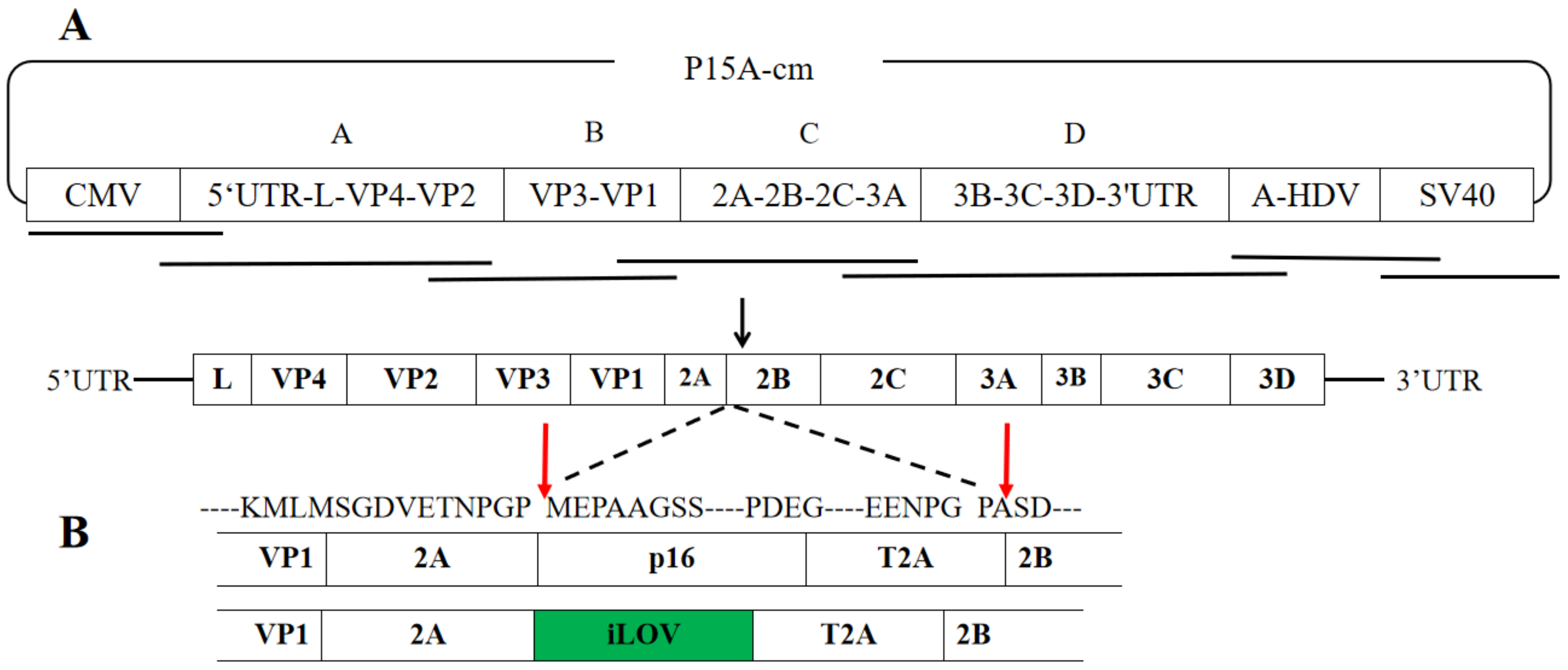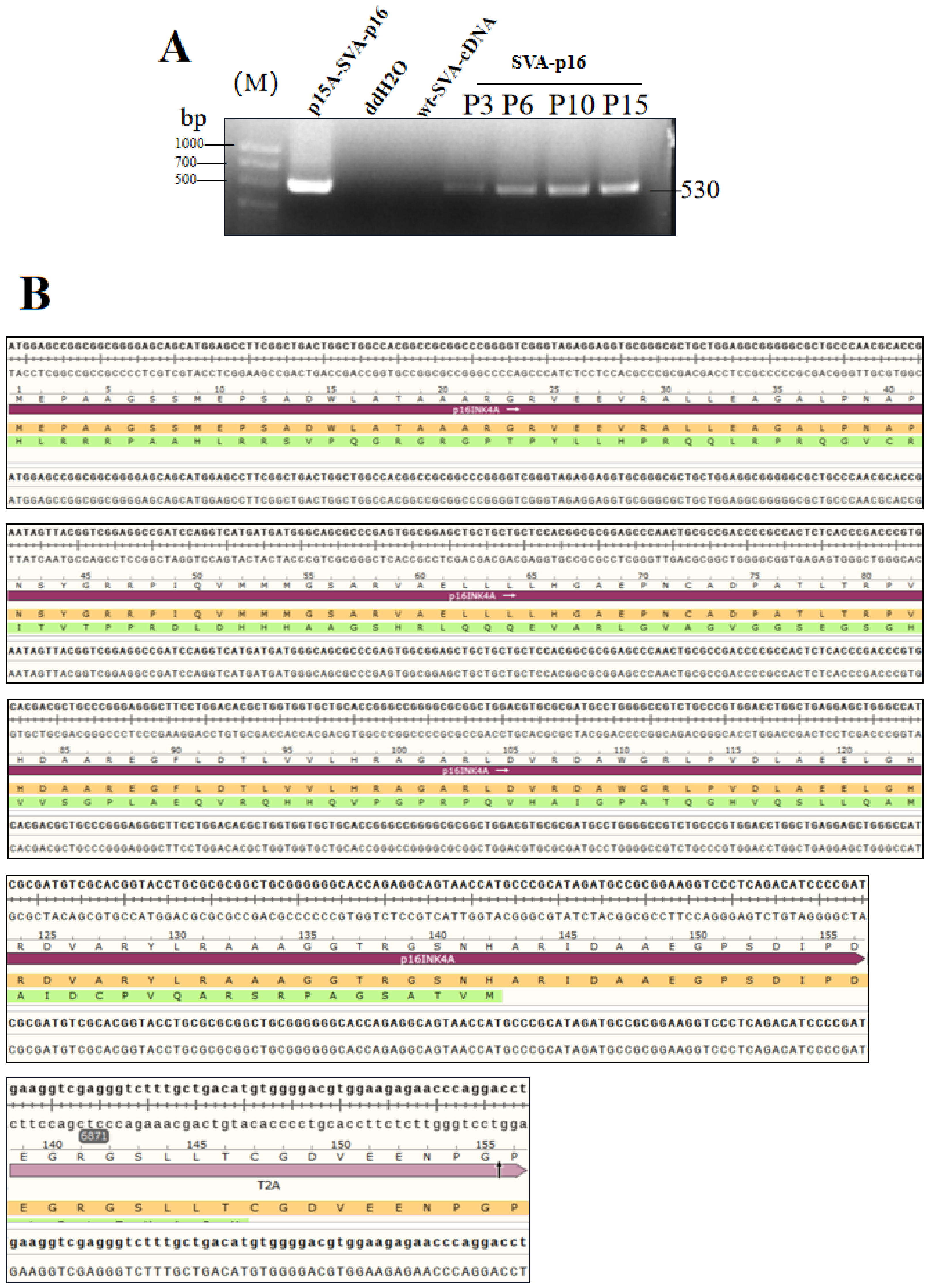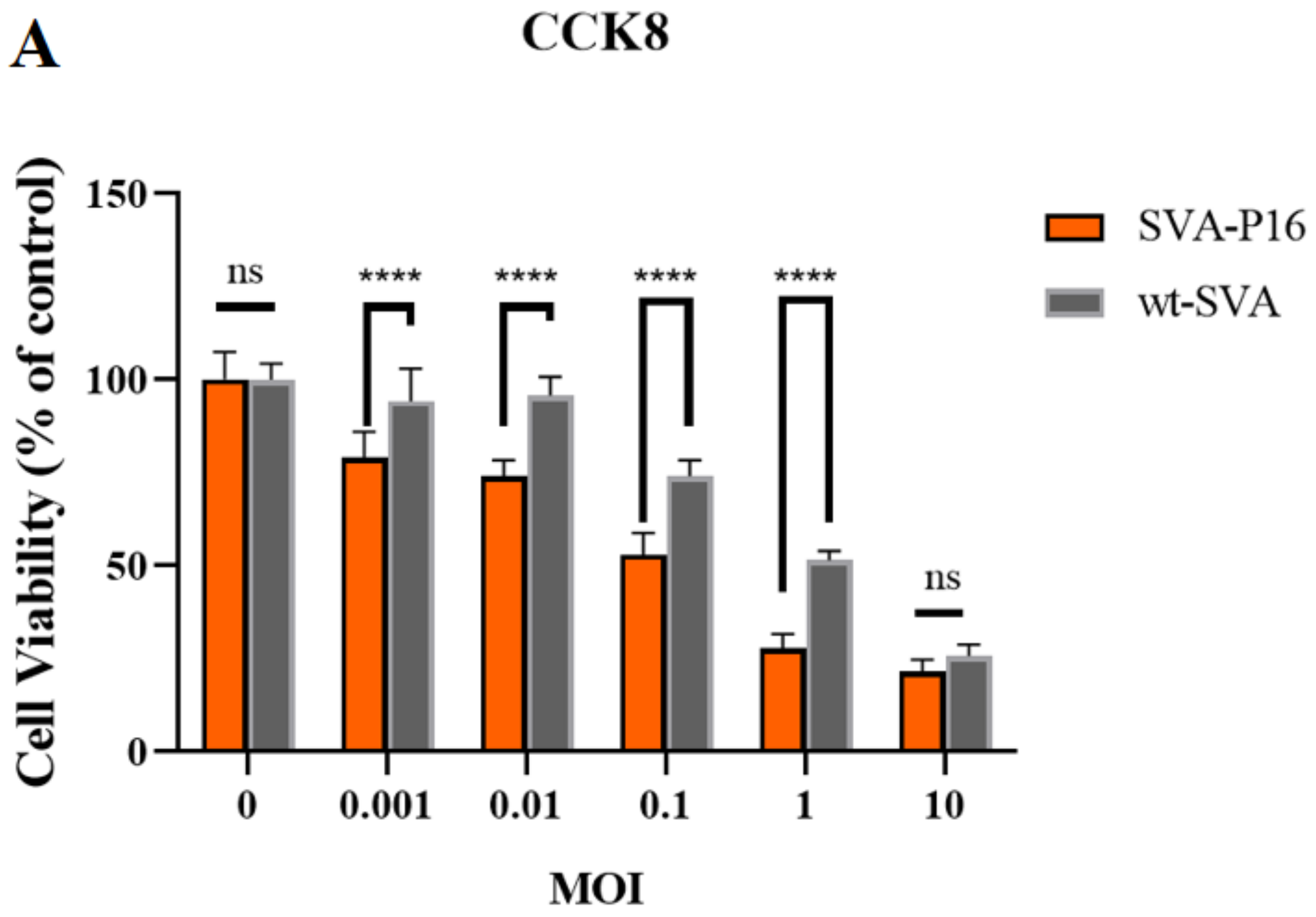Infectious Recombinant Senecavirus A Expressing p16INK4A Protein
Abstract
1. Introduction
2. Result
2.1. Construction and Characterization of Recombinant SVA Viruses
2.2. Rescue and Characterization of Recombinant SVA Viruses
2.3. Genetic Stability of the Recombinant Viruses in Seral of Passages
2.4. Growth Kinetics
2.5. Oncolytic Effects of SVA-p16 in Ishikawa Cells
3. Discussion
4. Materials and Methods
4.1. Cell and Virus
4.2. Construction of SVA Full-Length cDNA and Recombinant SVA Viruses
4.3. Recovery of Recombinant Viruses
4.4. RT-PCR Analysis
4.5. The Growth Curve of Recombinant Viruses
4.6. Western Blot Analysis
4.7. Indirect Immunofluorescence Assay (IFA)
4.8. Oncolytic Effects of SVA-p16 in Ishikawa Cells
4.9. Statistical Analysis
Author Contributions
Funding
Institutional Review Board Statement
Informed Consent Statement
Data Availability Statement
Acknowledgments
Conflicts of Interest
References
- Chiocca, E.A.; Rabkin, S.D. Oncolytic viruses and their application to cancer immunotherapy. Cancer Immunol. Res. 2014, 2, 295–300. [Google Scholar] [CrossRef] [PubMed]
- Maroun, J.; Muñoz-Alía, M.; Ammayappan, A.; Schulze, A.; Peng, K.W.; Russell, S. Designing and building oncolytic viruses. Future Virol. 2017, 12, 193–213. [Google Scholar] [CrossRef] [PubMed]
- Russell, S.J.; Peng, K.W.; Bell, J.C. Oncolytic virotherapy. Nat. Biotechnol. 2012, 30, 658–670. [Google Scholar] [CrossRef] [PubMed]
- Li, X.; Huang, L.L.; Xie, H.Y. Current status and prospects of oncolytic virotherapy. Chin. J. Cancer Biother. 2020, 27, 559–565. [Google Scholar] [CrossRef]
- Kelly, E.; Russell, S.J. History of oncolytic viruses: Genesis to genetic engineering. Mol. Ther. 2007, 15, 651–659. [Google Scholar] [CrossRef]
- Jhawar, S.R.; Thandoni, A.; Bommareddy, P.K.; Hassan, S.; Kohlhapp, F.J.; Goyal, S.; Schenkel, J.M.; Silk, A.W.; Zloza, A. Oncolytic viruses-natural and genetically engineered cancer immunotherapies. Front. Oncol. 2017, 7, 202. [Google Scholar] [CrossRef] [PubMed]
- Liu, X.Y. Targeting Gene-Virotherapy of Cancer and its prosperity. Cell Res. 2006, 11, 879–886. [Google Scholar] [CrossRef]
- Cattaneo, R.; Miest, T.; Shashkova, E.V.; Barry, M.A. Reprogrammed viruses as cancer therapeutics: Targeted, armed and shielded. Nat. Rev. Microbiol. 2008, 6, 529–540. [Google Scholar] [CrossRef]
- Reddy, P.S.; Burroughs, K.D.; Hales, L.M.; Ganesh, S.; Jones, B.H.; Idamakanti, N.; Hay, C.; Li, S.S.; Skele, K.L.; Vasko, A.J.; et al. Seneca valley virus, a systemically deliverable oncolytic picornavirus, and the treatment of neuroendocrine cancers. J. Natl. Cancer Inst. 2007, 99, 1623–1633. [Google Scholar] [CrossRef] [PubMed]
- Seago, J.; Juleff, N.; Moffat, K.; Berryman, S.; Christie, J.M.; Charleston, B.; Jackson, T. An infectious recombinant foot-and-mouth disease virus expressing a fluorescent marker protein. J. Gen. Virol. 2013, 94, 1517–1527. [Google Scholar] [CrossRef]
- Liu, F.X.; Wang, Q.Q.; Huang, Y.L.; Wang, N.; Shan, H. Rescue of NanoLuc luciferase-expressing Senecavirus A with oncolytic activity. Virus Res. 2021, 292, 198232. [Google Scholar] [CrossRef]
- Wang, M.M.; Mou, C.X.; Chen, M.; Chen, Z.H. Infectious recombinant Senecavirus A expressing novel reporter proteins. Appl. Microbiol. Biotechnol. 2021, 105, 2385–2397. [Google Scholar] [CrossRef] [PubMed]
- Xiong, Y.; Zhang, H.; Beach, D. Subunit rearrangement of the cyclin dependent kinases is associated with cellular transformation. Genes. Dev. 1993, 7, 1572–1583. [Google Scholar] [CrossRef] [PubMed]
- Luo, C.W.; Zhou, S.; Zhou, Z.M.; Liu, Y.H.; Yang, L.; Liu, J.F.; Zhang, Y.F.; Li, H.Y.; Liu, Y.H.; Hou, F.F.; et al. Wnt9a promotes renal fibrosis by accelerating cellular senescence in tubular epithelial cells. J. Am. Soc. Nephrol. 2018, 29, 1238–1256. [Google Scholar] [CrossRef]
- Yang, H.; Wang, H.; Ren, J.; Chen, Q.; Chen, Z.J. cGAS is essential for cellular senescence. Proc. Natl. Acad. Sci. USA 2017, 114, E4612–E4620. [Google Scholar] [CrossRef]
- Shi, J.Z.; Wei, T.W.; Liu, J.B.; Wang, L.S. Advances of tumour biomarker P16INK4A in treatment of organ fibrosi. J. Med. Postgra 2021, 34, 93–96. [Google Scholar] [CrossRef]
- Chen, Z.; Yuan, F.; Li, Y.; Shang, P.; Schroeder, R.; Lechtenberg, K.; Henningson, J.; Hause, B.; Bai, J.; Rowland, R.R.R.; et al. Construction and characterization of a full-length cDNA infectious clone of emerging porcine Senecavirus A. Virology 2016, 497, 111–124. [Google Scholar] [CrossRef]
- Zhao, X.; Wu, Q.; Bai, Y.; Chen, G.; Zhou, L.; Wu, Z.; Li, Y.; Zhou, W.; Yang, H.; Ma, J. Phylogenetic and genome analysis of seven senecavirus A isolates in China. Transbound. Emerg. Dis. 2017, 64, 2075–2082. [Google Scholar] [CrossRef]
- Rudin, C.M.; Poirier, J.T.; Senzer, N.N.; Stephenson, J.J.; Loesch, D.; Burroughs, K.D.; Reddy, P.S.; Hann, C.L.; Hallenbeck, P.L. Phase I clinical study of Seneca Valley Virus (SVV-001), a replication-competent picornavirus, in advanced solid tumors with neuroendocrine features. Clin. Cancer Res. 2011, 17, 888–895. [Google Scholar] [CrossRef]
- Houston, E.; Temeeyasen, G.; Piñeyro, P.E. Comprehensive review on immunopathogenesis, diagnostic and epidemiology of Senecavirus A. Virus Res. 2020, 286, 198038. [Google Scholar] [CrossRef]
- Burke, M.J. Oncolytic Seneca Valley Virus: Past perspectives and future directions. Oncolytic Virotherapy 2016, 5, 81–89. [Google Scholar] [CrossRef] [PubMed]
- Liu, F.X.; Huang, Y.L.; Wang, Q.Q.; Shan, H. Construction of eGFP-Tagged Senecavirus A for Facilitating Virus Neutralization Test and Antiviral Assay. Viruses 2020, 12, 283. [Google Scholar] [CrossRef] [PubMed]
- Li, R.Y.; Gao, L.; Han, X.H.; Gong, W.C.; Sun, Y.; Ma, J.Y. Study on the oncolytic effect of swine SVA CH-01-2015. Chin. J. Vet. Med. 2023, in press. (In Chinese) [Google Scholar]
- Rayess, H.; Wang, M.B.; Srivatsan, E.S. Cellular senescence and tumor suppressor gene p16. Int. J. Cancer 2012, 130, 1715–1725. [Google Scholar] [CrossRef] [PubMed]
- Sharpless, N.E. INK4a/ARF: A multifunctional tumor suppressor locus. Mutat. Res. 2005, 576, 22–38. [Google Scholar] [CrossRef]
- Denchi, E.L.; Attwooll, C.; Pasini, D.; Helin, K. Deregulated E2F activity induces hyperplasia and senescence-like features in the mouse pituitary gland. Mol. Cell Biol. 2005, 25, 2660–2672. [Google Scholar] [CrossRef]
- Hara, E.; Smith, R.; Parry, D.; Tahara, H.; Stone, S.; Peters, G. Regulation of p16CDKN2 expression and its implications for cell immortalization and senescence. Mol. Cell Biol. 1996, 16, 859–867. [Google Scholar] [CrossRef]
- Indovina, P.; Acquaviva, A.; De, F.G.; Rizzo, V.; Onnis, A.; Luzzi, A.; Giorgi, F.; Hadjistilianou, T.; Toti, P.; Tomei, V.; et al. Downregulation and aberrant promoter methylation of p16INK4A: A possible novel heritable susceptibility marker to retinoblastoma. J. Cell Physiol. 2010, 223, 143–150. [Google Scholar] [CrossRef]
- Serrano, M. The tumor suppressor protein p16INK4A. Exp. Cell Res. 1997, 237, 7–13. [Google Scholar] [CrossRef]
- Twumasi-Boateng, K.; Pettigrew, J.L.; Kwok, Y.Y.E.; Bell, J.C.; Nelson, B.H. Oncolytic Viruses as Engineering platforms for combination immunotherapy. Nat. Rev. Cancer 2018, 18, 419–432. [Google Scholar] [CrossRef]
- Tong, X.H.; Tang, R.; Xiao, M.M.; Xu, J.; Wang, W.; Zhang, B.; Liu, J.; Yu, X.J.; Shi, S. Targeting cell death pathways for cancer therapy: Recent developments in necroptosis, pyroptosis, ferroptosis, and cuproptosis research. J. Hematol. Oncol. 2022, 15, 174. [Google Scholar] [CrossRef] [PubMed]
- Choudhury, S.M.; Ma, X.S.; Zeng, Z.B.; Luo, Z.K.; Li, Y.Y.; Nian, X.F.; Ma, Y.H.; Shi, Z.W.; Song, R.; Zhu, Z.X.; et al. Senecavirus a 3D Interacts with NLRP3 to Induce IL-1β Production by Activating NF-κB and Ion Channel Signals. Microbiol. Spectr. 2022, 10, e020972. [Google Scholar] [CrossRef] [PubMed]
- Vousden, K.H.; Lu, X. Live or let die: The cell’s response to p53. Nat. Rev. Cancer 2002, 2, 594–604. [Google Scholar] [CrossRef] [PubMed]
- Stan, S.D.; Zeng, Y.; Singh, S.V. Ayurvedic medicine constituent withaferin a causes G2 and M phase cell cycle arrest in human breast cancer cells. Nutr. Cancer 2008, 60, 51–60. [Google Scholar] [CrossRef] [PubMed]
- Muniraj, N.; Siddharth, S.; Sharma, D. Bioactive Compounds: Multi-Targeting Silver Bullets for Preventing and Treating Breast Cancer. Cancers 2019, 11, 1563. [Google Scholar] [CrossRef]
- Reed, L.J.; Muench, H.A. Simple Method for Estimating 50% Endpoints. Am. J. Hyg. 1938, 27, 493–497. [Google Scholar] [CrossRef]







| Primers | Sequences (5′to 3′) | Length of RT-PCR Product (bp) | ||
|---|---|---|---|---|
| rSVA-p16 | p15A-SVA-p16 | rSVA | ||
| F1 | ctgatgcaatcaggcgacgt | 530 | 530 | None |
| R1 | gtcagcaaagaccctcgacc | |||
Disclaimer/Publisher’s Note: The statements, opinions and data contained in all publications are solely those of the individual author(s) and contributor(s) and not of MDPI and/or the editor(s). MDPI and/or the editor(s) disclaim responsibility for any injury to people or property resulting from any ideas, methods, instructions or products referred to in the content. |
© 2023 by the authors. Licensee MDPI, Basel, Switzerland. This article is an open access article distributed under the terms and conditions of the Creative Commons Attribution (CC BY) license (https://creativecommons.org/licenses/by/4.0/).
Share and Cite
Gong, W.; Zhao, X.; Tang, X.; Gao, L.; Sun, Y.; Ma, J. Infectious Recombinant Senecavirus A Expressing p16INK4A Protein. Int. J. Mol. Sci. 2023, 24, 6139. https://doi.org/10.3390/ijms24076139
Gong W, Zhao X, Tang X, Gao L, Sun Y, Ma J. Infectious Recombinant Senecavirus A Expressing p16INK4A Protein. International Journal of Molecular Sciences. 2023; 24(7):6139. https://doi.org/10.3390/ijms24076139
Chicago/Turabian StyleGong, Wencheng, Xiaoya Zhao, Xiaoyu Tang, Long Gao, Yuan Sun, and Jingyun Ma. 2023. "Infectious Recombinant Senecavirus A Expressing p16INK4A Protein" International Journal of Molecular Sciences 24, no. 7: 6139. https://doi.org/10.3390/ijms24076139
APA StyleGong, W., Zhao, X., Tang, X., Gao, L., Sun, Y., & Ma, J. (2023). Infectious Recombinant Senecavirus A Expressing p16INK4A Protein. International Journal of Molecular Sciences, 24(7), 6139. https://doi.org/10.3390/ijms24076139




